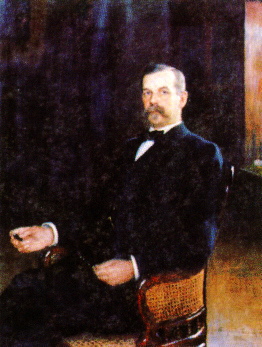
Svalbard, also known as Spitsbergen, or Spitzbergen, is a Norwegian archipelago in the Arctic Ocean. North of mainland Europe, it lies about midway between the northern coast of Norway and the North Pole. The islands of the group range from 74° to 81° north latitude, and from 10° to 35° east longitude. The largest island is Spitsbergen, followed in size by Nordaustlandet and Edgeøya. The largest settlement is Longyearbyen.

Spitsbergen is the largest and the only permanently populated island of the Svalbard archipelago in northern Norway.

Christian Gottfried Ehrenberg was a German naturalist, zoologist, comparative anatomist, geologist, and microscopist. Ehrenberg was an evangelist and was considered to be of the most famous and productive scientists of his time.

Nils Adolf Erik Nordenskiöld was a Finland-Swedish aristocrat, geologist, mineralogist and Arctic explorer. He was a member of the Fenno-Swedish Nordenskiöld family of scientists and held the title of a friherre (baron).
The polar archipelago of Svalbard was first discovered by Willem Barentsz in 1596, although there is disputed evidence of use by Pomors or Norsemen. Whaling for bowhead whales started in 1611, dominated by English and Dutch companies, though other countries participated. At that time there was no agreement about sovereignty. Whaling stations, the largest being Smeerenburg, were built during the 17th century, but gradually whaling decreased. Hunting was carried out from the 17th century by Pomors, but from the 19th century it became more dominated by Norwegians.

Johan Oskar Backlund was a Swedish-Russian astronomer. His name is sometimes given as Jöns Oskar Backlund, however even contemporary Swedish sources give "Johan". In Russia, where he spent his entire career, he is known as Oskar Andreevich Baklund. Russian sources sometimes give his dates of birth and death as 16 April 1846 and 16 August 1916, since Russia still used the Julian calendar at the time.

Nils Christoffer Dunér was a Swedish astronomer. His parents were Nils Dunér and Petronella.

Edgeøya, occasionally anglicised as Edge Island, is a Norwegian island located in southeast of the Svalbard archipelago; with an area of 5,073 square kilometres (1,960 sq mi), it is the third-largest island in this archipelago. An Arctic island, it forms part of the Søraust-Svalbard Nature Reserve, home to polar bears and reindeer. An ice field covers its eastern side. The island takes its name from Thomas Edge, an English merchant and whaler. It is seldom visited today and development of tourist facilities is forbidden by law because of its nature reserve status.

Danes Island is an island in Norway's Svalbard archipelago in the Arctic Ocean with an area of 40.6 km2 (15.7 sq mi). It lies just off the northwest coast of Spitsbergen, the largest island in the archipelago, near to Magdalenefjorden. Just to the north lies Amsterdam Island. Most of Svalbard's islands, including Danes Island, are uninhabited; only Spitsbergen, Bjørnøya and Hopen have settlements.

Gunnar Hansen Horn was a Norwegian petroleum geologist and Arctic explorer. He is most renowned as the leader of the Bratvaag Expedition that found the long-lost remains of S. A. Andrée's Arctic balloon expedition of 1897 at Kvitøya in 1930. The headland Hornodden of Kvitøya is named after him.
Svalbard is an Arctic, wilderness archipelago comprising the northernmost part of Norway. It is mostly uninhabited, with only about 3,000 people, yet covers an area of 61,020 square kilometres (23,560 sq mi).
Lovénberget is a mountain in Ny-Friesland at Spitsbergen, Svalbard. It is located on Lomfjordhalvøya. Lovénberget is among the largest bird cliffs of Svalbard, the steep cliffs with heights of more than 400 meters facing east towards Hinlopen Strait. It is named after Swedish zoologist Sven Ludvig Lovén.
Lovénvatnet is a lake in Oscar II Land at Spitsbergen, Svalbard. The lake is named after Swedish zoologist Sven Ludvig Lovén. It is located between the mountain ridges of Värmlandryggen and Geologryggen.
Kapp Lovén is a headland in Gustav V Land at Nordaustlandet, Svalbard. It is located at the eastern side of Planciusbukta and west of Rijpfjorden, north of the mountain Båtkvelvet. The headland is named after Swedish zoologist Sven Ludvig Lovén.

Lovénøyane is a group of seven islands and islets in Kongsfjorden in Haakon VII Land at Spitsbergen, Svalbard. They are named after Swedish zoologist Sven Ludvig Lovén. The largest of the islands is Storholmen, and the six others are Juttaholmen, Observasjonsholmen, Sigridholmen, Midtholmen, Innerholmen and Leirholmen.

Kapp Borthen is a headland in Wedel Jarlsberg Land at Spitsbergen, Svalbard. It is located at the western coast of Spitsbergen, at the front of the glacier Torellbreen. The headland is named after Norwegian ship-owner Harry Borthen.
Dunérbukta is a bay at the western shore of Storfjorden in Sabine Land at Spitsbergen, Svalbard. It is named after Swedish astronomer Nils Christoffer Dunér. The glacier of Ulvebreen debouches into the bay. At the northern side of the bay is the mountain of Domen and the ridge Kapp Johannesen.

Johan Hjalmar Théel was a Swedish zoologist and university professor.
Cape Amsterdam is a headland in Nordenskiöld Land on Spitsbergen on Svalbard. Headland marks the northwestern entrance to Svea Gulf that continues north to Sveagruva.
Klöden Island is a minor island in the Bastian Islands in the Svalbard archipelago. It lies east of Wilhelm Island and northeast of Spitsbergen.












